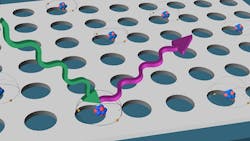Artificial atoms produce single photons at room temperature
IMAGE:These patterned bright spots are artificial atoms and possess many of the same properties of real atoms, like single-photon emission. (Image credit: University of Oregon)
Ultra-secure online communications, completely indecipherable if intercepted, are a step closer with the help of a recently published discovery by University of Oregon (UO; Eugene, OR) physicist Ben Alemán.
Alemán, a member of the UO's Center for Optical, Molecular, and Quantum Science, has made artificial atoms that work in ambient conditions. The research, published in the journal Nano Letters, could be a big step in efforts to develop secure quantum communication networks and all-optical quantum computing.
"The big breakthrough is that we've discovered a simple, scalable way to nanofabricate artificial atoms onto a microchip, and that the artificial atoms work in air and at room temperature," said Alemán, also a member of the UO's Materials Science Institute.
"Our artificial atoms will enable lots of new and powerful technologies," he said. "In the future, they could be used for safer, more secure, totally private communications, and much more powerful computers that could design life-saving drugs and help scientists gain a deeper understanding of the universe through quantum computation."
Joshua Ziegler, a doctoral student researcher in Alemán's lab, and colleagues drilled holes--500 nm wide and 4 nm deep--into a thin 2D sheet of hexagonal boron nitride, which is also known as white graphene because of its white color and atomic thickness.
To drill the holes, the team used a process that resembles pressure-washing, but instead of a water jet uses a focused beam of ions to etch circles into the white graphene. They then heated the material in oxygen at high temperatures to remove residues.
Using optical confocal microscopy, Ziegler next observed tiny spots of light coming from the drilled regions. After analyzing the light with photon counting techniques, he discovered that the individual bright spots were emitting light at the lowest possible level--a single photon at a time.
These patterned bright spots are artificial atoms and they possess many of the same properties of real atoms, like single-photon emission.
With the success of the project, Alemán said, the UO is now ahead of the pack in efforts to develop such materials in quantum research. And that puts a smile on Alemán's face.
When he joined the UO in 2013, he had planned to pursue the idea that artificial atoms could be created in white graphene. However, before Alemán could set his own research in motion, another university team identified artificial atoms in flakes of white graphene.
Alemán then sought to build on that discovery. Fabricating the artificial atoms is the first step towards harnessing them as sources of single particles of light in quantum photonic circuits, he said.
"Our work provides a source of single photons that could act as carriers of quantum information or as qubits. We've patterned these sources, creating as many as we want, where we want," Alemán said. "We'd like to pattern these single photon emitters into circuits or networks on a microchip so they can talk to each other, or to other existing qubits, like solid-state spins or superconducting circuit qubits."
Co-authors on paper were UO doctoral students Joshua Ziegler, Rachael Klaiss, Andrew Blaikie and David Miller, and Viva Horowitz, a professor of physics at Hamilton College in New York, who spent summer 2018 in Alemán’s lab as a visiting professor.
The National Science Foundation-supported research was done in Alemán's lab, the UO's Center for Advanced Materials Characterization in Oregon and the Oregon Rapid Materials Prototyping Facility. The latter was established in 2016 by an award from the M. J. Murdock Charitable Trust.
SOURCE: University of Oregon; https://www.rdmag.com/news/2019/04/researchers-create-artificial-atoms-work-room-temperature?type=headline&et_cid=6669040&et_rid=353748594&linkid=Mobius_Link
About the Author

Gail Overton
Senior Editor (2004-2020)
Gail has more than 30 years of engineering, marketing, product management, and editorial experience in the photonics and optical communications industry. Before joining the staff at Laser Focus World in 2004, she held many product management and product marketing roles in the fiber-optics industry, most notably at Hughes (El Segundo, CA), GTE Labs (Waltham, MA), Corning (Corning, NY), Photon Kinetics (Beaverton, OR), and Newport Corporation (Irvine, CA). During her marketing career, Gail published articles in WDM Solutions and Sensors magazine and traveled internationally to conduct product and sales training. Gail received her BS degree in physics, with an emphasis in optics, from San Diego State University in San Diego, CA in May 1986.
